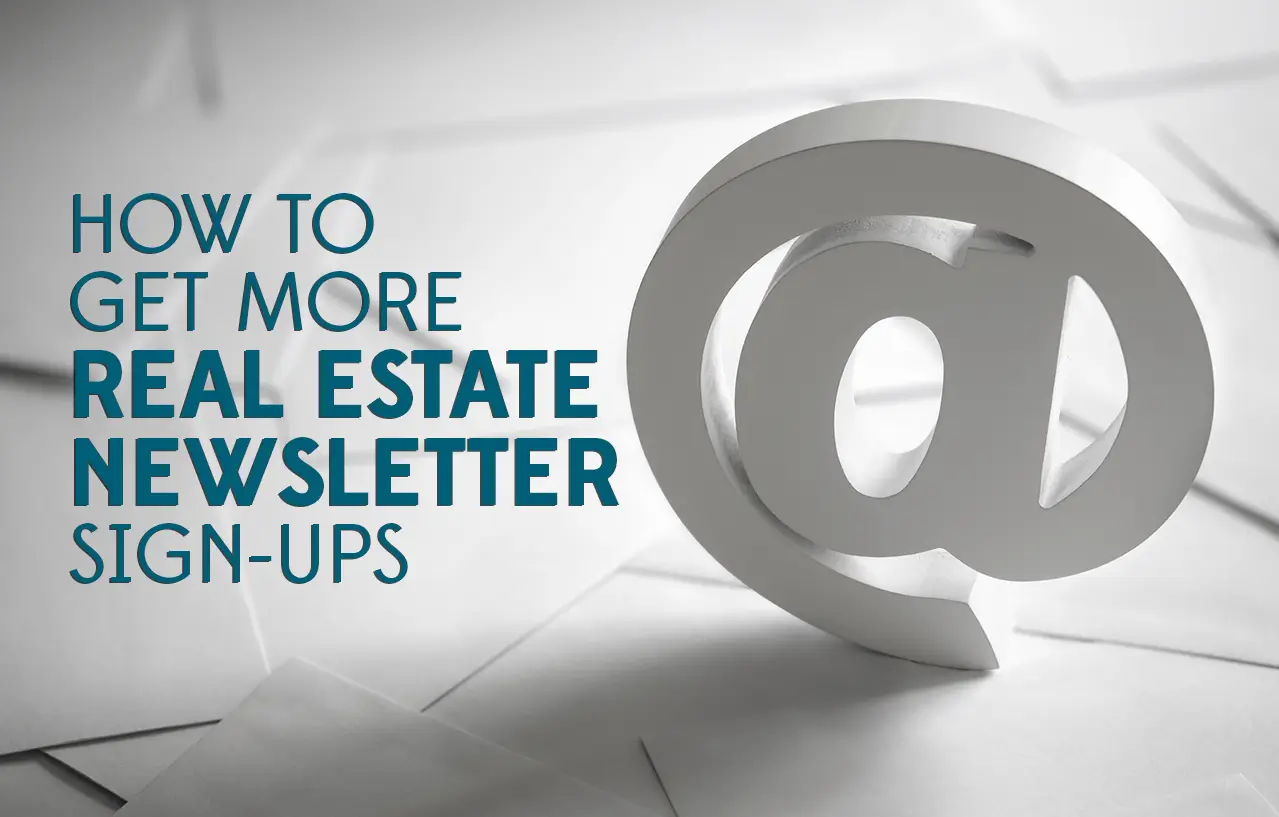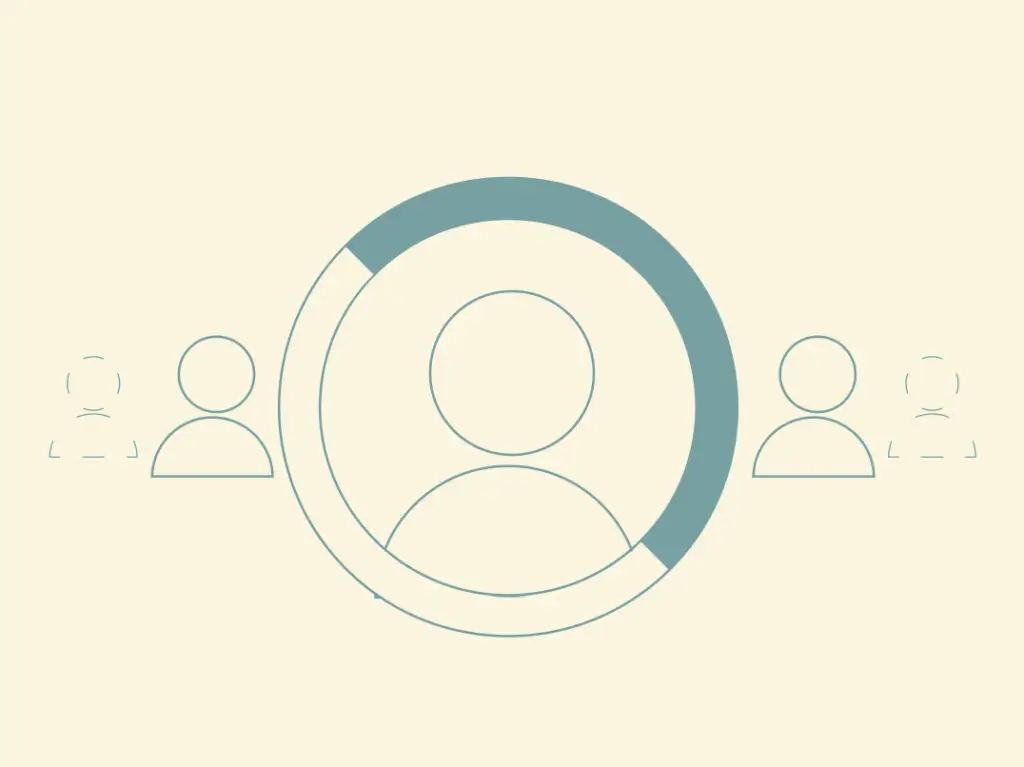Maintaining healthy email marketing lists means striking a delicate balance between lead generation and lead maintenance. Not only do you have to come up with amazing ways to attract subscribers, but then you have to encourage them to stay subscribed so you’ll have plenty of people you can market to.
Making a push to increase subscribers for your real estate newsletter should be one of your highest marketing priorities. Why?
- The average lead moves far through the sales cycle via content marketing before they choose to contact you or convert. Email marketing allows you to have critical, valuable, and educational “discussions” with your prospective customers well before they’re prepared to make any sales decisions.
- 78% of users prefer to get to know companies through educational content.
- Email has a higher ROI and higher conversions rates per website visitor session than search and social combined.
- 91% of users check email daily, making it the perfect avenue to stay top-of-mind with users.
This post will outline real estate marketing ideas to increase newsletter subscribers.
Choose your website’s lead capture areas.
When you’re focused on newsletter growth, increased visibility of your opt-in forms contributes to sign-ups. Where you put your boxes and forms matters. You can choose opt-in forms that appear in the following areas:
- Sidebar: These boxes or forms appear alongside your website content in a fixed vertical bar.
- Top bar: Often, these are fixed thin bars with a short call to action and enough space for email entry. This type of opt-in generally stays in view as the user moves through your website.
- Top feature box: A prominent box you can include on pages to attract subscriptions. Because these appear above the fold, they often get lots of engagement.
- Floating box: These opt-in areas appear in a corner and can follow the user up and down the page as they navigate your content.
- End-of-post: Buttons and calls to action at the end of a quality post are a great transition for users who have indulged in and enjoyed a piece of content.
- Footer: Much like the top bar opt-in area, you can include a fixed footer bar to remind folks of your newsletter.
- Pop-up: This newsletter opt-in type tends to convert at high rates, since it shows up prominently in the center of the page, blocks content, and makes visitors decide whether they’ll fill out the form or click away.
Highlight opt-in opportunities with strategic positioning.
While you want your email opt-in opportunities to be highly visible, you don’t want to overload readers and look spammy by including a million on one page. Every page on your website should have at least one newsletter subscription form, but some pages should have multiple. Focus on placing multiple sign-up forms on pages where you know users are engaging most. Use Google Analytics to track the pages with the most and longest views (explained in further detail below), install on-page behavior heat map tools to see what areas of pages are getting the most touches, and place newsletter opt-in boxes and buttons there strategically.
Click below to learn best practices for creating assets for each of these opt-in types, and which may work best for your newsletter.


Features of a great email opt-in area.
Placements of opt-in forms is just the first step. Next, you must effectively “sell” your newsletter to the user. Below are staples of great newsletter subscription forms and boxes. Use these elements to get the highest return:
- Header. Use persuasive language to highlight the focus of your opt-in area: signing up for your newsletter.
- Value pitch. Present the value you’ll provide when a user signs up. Include statistics about your subscriber list, social proof from testimonials, etc.
- Call to action (CTA). Tell the reader exactly what you’d like them to do (in this case, sign up or provide an email address) with a compelling call to action.
- The incentive. Showcase the benefits afforded to the user by being a part of your list. Focus on details of content and frequency, but also highlight how the person has an inside scoop or first-look at important real estate information. Describe what being part of your email list entails.
- Short forms. Studies have shown that having too many form fields in your lead capture form can decrease conversions. Considering newsletter leads can be at a variety of stages in the customer journey, you don’t want to turn off leads who aren’t ready to give all of their personal information. It’s often best to only ask for email and name.
- Great visual elements. Too many websites create forms that are hidden with colors or lettering that blend into the rest of the page. When trying to grow your list, don’t be shy about using bold creative: that means colors, graphics, images, and fonts that grab a user’s attention. Consider using a graphic designer to create eye-catching assets so they’ll receive high engagement.
- Branding. As with your other real estate marketing, branding can help sell your newsletter. Give it a catchy name users will remember and match that to the subsequent calls to action and newsletter landing page URL.
Use a dedicated landing page to grow your email list.
You should always have a dedicated landing page for your newsletter. It will not replace your website opt-in forms, rather it will work in conjunction with all of your other website marketing to enhance the visibility of your real estate newsletter. And, many of the examples discussed in this post will prove why have a newsletter landing page will streamline the process for getting more subscribers. Here are some benefits:
- A destination you can share. Not every sign-up will come from someone interacting with your website, and you don’t want to send users to your homepage and hope they find your newsletter sign-up opt-in form. Sending users to a dedicated landing page with one specific call to action and goal increases the likelihood they’ll take the action you want. This landing page can be used to redirect users who click on links associated with advertisements, social media posts, transactional emails, and anywhere else you choose to market your newsletter.
- Space to develop your selling points. A landing page gives you more room than just a form or box to outline the benefits of your newsletter and develop a relationship with the reader.
- Search engine optimization value. Reusing targeted long-tail keyword phrases on these pages can increase your organic rank potential and increase traffic directly from search engines.
How to create an effective landing page for your newsletter:
- Streamline focus. Create a page that doesn’t have all of the other elements of your website. That means removing the usual navigation bar, links to any other pages, etc.
- Include details. Outline what users can expect to read, how often, visual previews of the types of content you typically send, and a value proposition that lets leads feel in-the-know when it comes to joining your newsletter list.
- Use a shareable link that emphasizes the content in your newsletter. It also helps to have a URL that includes a CTA in it, like “/signupforrealestatenews.”
Offer free resources to attract subscriptions.
Nothing can sell quite like a free tangible giveaway. Adding incentives like free downloads (marketing resources, buyers and sellers guides, ebooks) or access to sneak peeks, tours, and live webinars can help you attract sign-ups. Most of your marketing will focus on the actual giveaway or event, but you’ll be able to translate that interest into sign-ups automatically, or by providing a box that allows users to sign-up. Just make it clear to the user when they provide their email they’ll also be opting in to your newsletter for more great content and giveaways.
Use your network.
Your network can be extremely powerful in garnering support for your newsletter. See if friends and colleagues who have websites can host an “ad” for your newsletter list right on their website. You can direct them from the ad to a special landing page to sign up and track how many leads come from those sources. Not sure who to ask? If you’re in with local businesses, see if they’d be willing to host your ad. Offer sponsorship or a shoutout on your website via a blog post or a preferred vendor list.
Offer an email course.
New and transitioning buyers and sellers are eager for information, but they often also experience information-overload anxiety. An email course offers a perfect way to engage with these users because there’s perceived value in your daily emails. To maximize your newsletter course,
- Emphasize in your marketing push that this is outside your regular email newsletter (i.e. extra special!).
- Offer it at a higher frequency for a shorter period of time to stay top-of-mind with participants.
- Advertise your email course via your website, social media, PPC advertising, and email, of course.
- Develop a special course that guides users through a compelling topic, and include links to resources that will be helpful, both from your real estate website and from other sites.
- Leverage special giveaway items, like downloadable templates, to keep users engaged and willing to participate.
- Follow up with participants personally to see if they’d like more resources.
- Always include a statement that lets users know they’ll be opted-in to your general newsletter. This allows you to keep the conversation going long after your course.
Advertise to get more subscribers.
If you have a great newsletter and getting more readers is a high priority, then you should consider advertising your newsletter. This investment allows you to reach a wider audience with your real estate newsletter marketing.
- Pay per click (PPC) ads appear in search engines and work best when supported by a solid strategy for targeting niche keywords, strategic ad copy worth clicking, and a strong destination landing page.
- Social media ads can include imagery and offer you the ability to target specific demographics, or retarget users who are in your leads database.
For both of these ad types, create a mix of ads: Ones that ask users directly to join your newsletter and others that offer a download highlighting a high-interest topic (where providing email would opt a user into your email list). Then, A/B test them against each other to see which strategy yields the most sign-ups.
Leverage social media.
Social media offers ample opportunities to generate newsletter subscribers. And likely, there are social media followers you have right now that aren’t aware you have a newsletter. Here are some ways to use social to spread word of your real estate newsletter and get more subscribers:
Add links to your bios.
Each platform offers different space restrictions on user bios, but many bio areas on Facebook, LinkedIn, Instagram, and Google+, allow space where you can add a link users can click (directing to your dedicated landing page) to join your newsletter. If you’re getting ample website traffic and solely want to focus on newsletter subscribers for an extended period of time, you could even change your “website address” on Twitter and other social channels to your newsletter landing page.
Use built-in social features to highlight your newsletter.
Many of these platforms also allow email integrations that attract and make it simple for users to sign up. Having a newsletter landing page also allows you to direct traffic from two interesting places on social:
- Facebook call to action buttons you can customize with “Sign Up.”
- Twitter Lead Generation Cards that look like ads and offer seamless sign-up.
Schedule social posts about your newsletter.
You’re used to sharing posts about listings and articles, but tweeting, posting, and sharing information about your newsletter is a great way to generate clicks to your newsletter’s landing page. As mentioned above, just because someone is following you doesn’t mean they’re aware of your valuable newsletter, but simply sharing a post about it can drastically increase engagement and sign-ups. When considering creating posts about this, use the same principles you would when creating opt-in forms, high-value social posts, and even advertisements:
- For copy, focus on a benefit to the user, highlight the value you’ll provide, or use social proof to attract people to join. And, always offer a call to action that entices users to sign up.
- Don’t skimp on creative. People love visuals, so include graphics or images that convey the value within your newsletters so you can attract the eye to your newsletter post.
Then, automate and schedule these posts using a social media scheduler so you can manage the consistency of your newsletter marketing.
Comment on your own posts.
Leverage your content promotion as a way to talk about your newsletter. Sharing a post about your latest market report? Share that post on social and add a note or comment with language like “Would you like to receive more posts like this in your inbox? Click here to sign up for my newsletter!”
Capitalize on lead capture opportunities on visual platforms.
While more visual social platforms feel like a place users wouldn’t be looking to sign up, many of these platforms integrate email subscription opportunities that receive high conversions.
First, start by including your newsletter sign-up link in bios on places like SlideShare and Youtube. Then, think about creative ways to use their built-in features:
- SlideShare offers a sign-up pop-up to place where you’d like in your presentation, allowing you to specifically ask for a viewer’s email and integrate it with your email list. There’s also space to add details about your presentation where you can drop your newsletter landing page link.
- YouTube offers pop-up elements that can appear during videos and direct users to the landing page of your choice. Additionally, it allows for ample content below your video where you’re able to include a sign-up link.
Market your newsletter in your email signature.
Every lead you converse with via email will see your email signature. Along with important details like your name, website, and contact information, provide a value proposition and a call to action that encourages them to sign up for your newsletter, with a link to your newsletter landing page.
Offer a simple ‘forward to a friend’ feature.
As you know, referrals from your network can amount to leads, so why not use this tactic for your email? Include a call to action and link within your newsletters to encourage users to forward your message to a friend. This word-of-email referral highlights to their network the value of your newsletter and enhances the likelihood they’ll visit your site and subscribe. Many email clients have special features to set up “forward to a friend” links for both ease of sign-up and so that users are given their own profile when they engage with your newsletter.
Write guest posts for high-traffic websites and blogs.
Many websites have built-in loyal followings, to the point where nearly everything written there is highly respected and regarded. Presenting your article on these platforms is a great way to grow your audience base and generate leads, but only if you ask correctly. While you shouldn’t spend this critical real estate trying to plug all of your services, think about ways to inject mentions of your newsletter. One such area is the bio that’s included with your post. Don’t stop at your name and title: Highlight in your author bio that weekly newsletter you send, with a link to your landing page or newsletter archive.
Use website data to optimize priority pages.
Data trackers like Google Analytics can help tremendously when it comes to optimizing your real estate website for sign-ups. Let’s say, for example, your main opt-in form is located on your homepage, but when looking at your website’s analytics, you realize the majority of your traffic enters your website through listings pages, but you don’t have strong newsletter opt-in opportunities there. This is a clear miss. That’s why it’s essential to look at the analytics metrics that matter like Users Flow, Behavior Flow, Pageviews, and Average Time on Page to see the pages that get the most entry traffic and most on-site engagement, and make sure these areas are primed for newsletter sign-ups.
Assess and streamline your website to highlight newsletter opt-in forms.
Website maintenance is essential to stay on top of trends and to tweak features that aren’t working well. Do your pages have too many link choices that just confuse people on the page of what you actually want them to do? Are there multiple calls to action per page? Distractions on your page can contribute to a sharp decline in generating newsletter sign-ups. This is a great time to assess your website design and streamline layouts so users will perform the most important actions for your goal — in this case building your email list with more subscribers.
Differentiate newsletter sign-ups from other lead capture forms.
Some forms on your real estate website focus on leads getting in touch you about a listing or services, and many leads who aren’t yet ready to get in touch and who are just perusing your website listings or looking at an article may not make an immediate connection between your opt-in form and a newsletter opportunity. Create separate opt-in areas for your newsletter with specially designated boxes, copy, creative, and colors so newsletter leads are seeing the most pertinent information for them.
Hold a live webinar.
Much like an email course, webinars allow you to attract an audience, start the lead nurturing process with great content, and generate emails to your database. When thinking about ways to attract users to your webinar, consider the topics and key phrases often searched by your audience and create content that simplifies those overwhelming topics. When users sign up, include an optional or automatic opt-in opportunity for your real estate newsletter, and set up drip campaigns to send attendees takeaway resources after the webinar. Then, follow up personally to see what leads thought of your presentation.
Create an archive of past newsletters.
If you send out newsletters regularly, having an archive of them can help sell your newsletter to prospective subscribers who want to learn more about the content of your emails. Set one up using these tips.
Include a privacy policy near sign-up fields.
Users are often shy about signing up for things. After all, the average user receives lots of email and doesn’t want to be trapped in another list that will overwhelm their inbox or one that will sell their personal information to other providers. Make users comfortable by including language from your privacy policy about how their information is protected and how they can unsubscribe whenever they wish. You can also link to your full privacy policy.
Create amazing website content and email newsletters.
This sounds like a no-brainer, but if you don’t have great content on either your website or in your newsletter, you’ll be hard-pressed to attract, engage, or retain subscribers. The good news is your content can easily help convert readers into subscribers if they find it extremely valuable. Once they’re hooked on your content, visitors will want to read more, and email brings with it the convenience of receiving content updates on a regular basis without having to search.
Revamp your blog strategy to include lots of great local topics, include curated content when you can’t do lots of original content creation from scratch, and consider making content upgrades to existing content to improve quality and search engine optimization.
Next, create great newsletters! Even if you’re hoping to attract new newsletter subscribers, you shouldn’t only focus on “subscriber generation” for your real estate email marketing. You should also be focusing on your active subscribers and incoming subscribers and how they’re engaged by your newsletter (because the unsubscribe button isn’t far away). Focus on crafting subject lines that get users excited to open your message, include emotional storytelling that keeps users engaged, and insert prominent calls to action that lead to great content on your real estate website. Also, focus on modern, mobile-friendly email marketing templates users will love, and personalize messages for your email lists as much as possible so users will feel like your messages are created specifically for them.
Prioritize your real estate email marketing tactics.
According to OkDork.com’s Noah Kagan, success with growing email campaigns comes partly by prioritizing all of your real estate marketing ideas and tactics and starting with one goal at a time. He chose 30-day increments to watch a tactic form before assessing its performance. Take note of the tactics you’d like to use in your marketing, prioritize them, and then focus on just one or two at a time, making sure to give each tactic a couple months of monitoring and tweaking before measuring success.
What tactics do you use to get more subscribers for your real estate newsletter? Let us know in a comment below!





